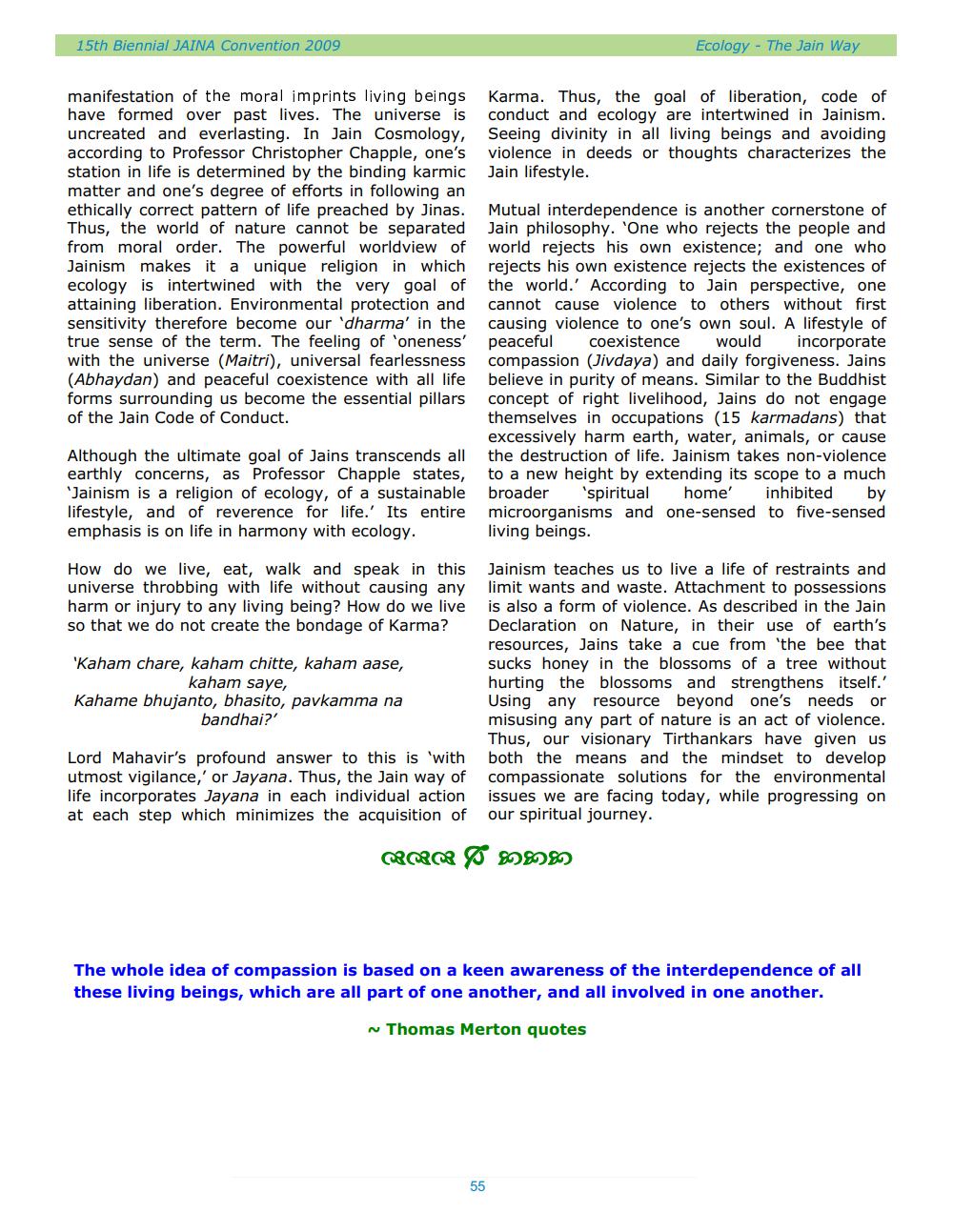________________
15th Biennial JAINA Convention 2009
Ecology - The Jain Way
manifestation of the moral imprints living beings Karma. Thus, the goal of liberation, code of have formed over past lives. The universe is conduct and ecology are intertwined in Jainism. uncreated and everlasting. In Jain Cosmology, Seeing divinity in all living beings and avoiding according to Professor Christopher Chapple, one's violence in deeds or thoughts characterizes the station in life is determined by the binding karmic Jain lifestyle. matter and one's degree of efforts in following an ethically correct pattern of life preached by Jinas. Mutual interdependence is another cornerstone of Thus, the world of nature cannot be separated Jain philosophy. 'One who rejects the people and from moral order. The powerful worldview of world rejects his own existence; and one who Jainism makes it a unique religion in which rejects his own existence rejects the existences of ecology is intertwined with the very goal of the world.' According to Jain perspective, one attaining liberation. Environmental protection and cannot cause violence to others without first sensitivity therefore become our 'dharma' in the causing violence to one's own soul. A lifestyle of true sense of the term. The feeling of 'oneness' peaceful coexistence would incorporate with the universe (Maitri), universal fearlessness compassion (Jivdaya) and daily forgiveness. Jains (Abhaydan) and peaceful coexistence with all life believe in purity of means. Similar to the Buddhist forms surrounding us become the essential pillars concept of right livelihood, Jains do not engage of the Jain Code of Conduct.
themselves in occupations (15 karmadans) that
excessively harm earth, water, animals, or cause Although the ultimate goal of Jains transcends all the destruction of life. Jainism takes non-violence earthly concerns, as Professor Chapple states, to a new height by extending its scope to a much 'Jainism is a religion of ecology, of a sustainable broader spiritual home inhibited by lifestyle, and of reverence for life.' Its entire microorganisms and one-sensed to five-sensed emphasis is on life in harmony with ecology.
living beings.
How do we live, eat, walk and speak in this universe throbbing with life without causing any harm or injury to any living being? How do we live so that we do not create the bondage of Karma?
'Kaham chare, kaham chitte, kaham aase,
kaham saye, Kahame bhujanto, bhasito, pavkamma na
bandhai?'
Jainism teaches us to live a life of restraints and limit wants and waste. Attachment to possessions is also a form of violence. As described in the Jain Declaration on Nature, in their use of earth's resources, Jains take a cue from the bee that sucks honey in the blossoms of a tree without hurting the blossoms and strengthens itself.' Using any resource beyond one's needs or misusing any part of nature is an act of violence. Thus, our visionary Tirthankars have given us both the means and the mindset to develop compassionate solutions for the environmental issues we are facing today, while progressing on our spiritual journey.
Lord Mahavir's profound answer to this is 'with utmost vigilance,' or Jayana. Thus, the Jain way of life incorporates Jayana in each individual action at each step which minimizes the acquisition of
ROW 898980
The whole idea of compassion is based on a keen awareness of the interdependence of all these living beings, which are all part of one another, and all involved in one another.
~ Thomas Merton quotes




